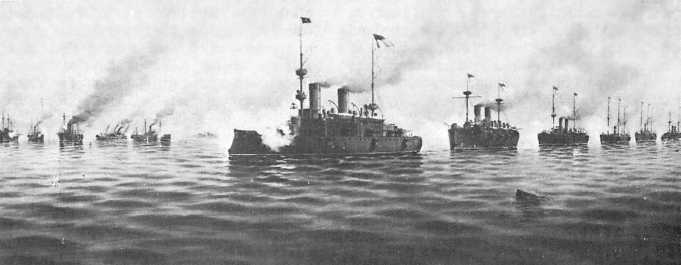| |
134.131
Figure 2-12.-Commodore George Dewey and his squadron sailed past the shore batteries of Manila Bay
on 1 May 1898 to smash the Spanish Pacific squadron of Rear Admiral Montojo, opening
the way
for the American occupation of the Philippines.
WORLD WAR I
SIGNIFICANT DATES
24 Sept. 1918 Lieutenant (JG) David S. Ingalls
becomes Navy’s first flying ace.
(The criterion for becoming an
“ace” is to down five enemy
planes.)
28 Feb. 1919 Destroyer Osmond Ingram, first
Navy ship named for an enlisted
man, launched.
27 Feb. 1928 Commander T. G. Ellyson, Navy’s
first aviator, killed in air crash.
28 Nov. 1929 First flight over South Pole by
Lieutenant Commander Richard E.
Byrd, who became the first to fly
over both poles.
Several days after our declaration of war against
Germany in April 1917, Rear Admiral William S.
Sims arrived in London. Admiral Sims, who had been
serving as President of the Naval War College in
Newport, was sent to confer with British First Sea
Lord, Admiral John Jellicoe. Explaining the status of
the submarine war, Jellicoe revealed that available
Allied shipping had been depleted by one-fourth and
losses were mounting at an appalling rate. April
losses alone threatened to reach the unprecedented
figure of 900,000 tons. Sims realized at that rate
England, with only a month’s grain supply on hand,
must starve or surrender within a few weeks’ time.
Germany was winning the war.
Germany was building submarines, called U-
boats, at the rate of three a week. Sims realized the
submarine menace had to be reduced drastically if
the Allies were to survive. He appealed to the Navy
Department for immediate dispatch of all available
destroyers and other antisubmarine craft, auxiliaries,
and merchant-men. Within a month after our entry
into the war, the first American naval forces began to
arrive in Britain ready for duty.
From a naval point of view, World War I was a
conflict of two blockades. The Allies maintained a
long-distance blockade of German ports; the
Germans, with the submarine, tried to blockade
British and French ports by attacking Allied
shipping. The unrestricted sinking of neutral
American merchant ships was one reason for our
entry into the war. The cruiser, the destroyer, and
the newly constructed submarine chaser performed
support service in that campaign against German
submarines.
The Allied victory resulted in part from the Sims-
inspired convoy system employed in transporting
about 2 million American fighting men to France.
Navy convoys also transported the munitions and
supplies needed to sustain Pershing’s armies and the
Allies.
2-15
|

